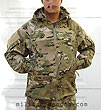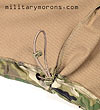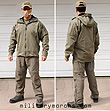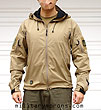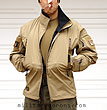Insulated Soft Shells Page 1
2 3 4
As a sizing reference: I'm 5'7", 155 lbs (yeah, I'm a little guy), medium build (BDU top medium/regular, BDU pant medium/short), waist 32", chest 43". Keep this in mind when you read my comments with respect to sizing, so you have an idea of how the garments featured below will fit on you. ALL garments in these pages are size Medium, unless stated otherwise.
TO VIEW FULL SIZE IMAGES: USERNAME and PASSWORD are both "mm"
| 5/17/08 - This is something a lot of people have been waiting for (I, for one) - a MultiCam Soft Shell. It's been a couple of years since I saw the prototype at the 2006 SHOT show in OTTE Gear's booth, and it's finally available now. OTTE's Soft Shell line is called the Alpine line (their hard shell/Patrol Parka is in the writeup below). Featured here is OTTE Gear's Alpine Jacket, in Crye MultiCam. It's also available in Black, Coyote and Foliage Green. A matching softshell pant is also available. Material - The OTTE Alpine Jacket is made of Tweave Durastretch fabric, which is a technical stretch woven with 91% nylon and 9% spandex for the shell/face material. It is a durable, abrasion resistant, water and wind resistant, low-bulk, breathable fabric with excellent stretch and recovery properties. The Multi-directional (4-way) permanent-stretch spandex has 100% memory for shape retention. It's laminated to a light lofting knit for some insulation. The moisture-wicking lining material is 90% polyester and 10% X-static fiber, which is a pure silver bonded to the surface of a textile fabric. The X-Static fiber is antimicrobial, which helps inhibit bacterial and fungal growth in the garment, reducing odor. It's also advertised to have excellent thermodynamic (temperature regulating) and moisture transfer properties that keep you "warm in winter and cool in summer" (not necessarily on the same garment, though). It eliminates static charges as well. Editor's note 7-25-09:
The Alpine Jacket with this fabric (X-static and nanosphere) is
no longer in production, and the fabric has been swapped for a lighter
weight stretch woven with DWR for the newer Alpine Jackets. It is
not lined with X-Static fabric. I have not seen this material. Only
the DK Jacket Heavy will be available in the Tweave with X-Static.
Contact OTTE directly for details if you're unsure of what you're
getting. Here's a summary of the features on the Alpine Jacket soft shell, size medium shown:
Sizing, fit etc - Shown here is the Medium size,
and as I mentioned before it's a very comfortable fit (on my build
- 155 lbs, 5' 7") that's not too snug nor loose, and without
excess material so it fits under rigs or body armour. The shape
of the rear panels that are sewn together to make up the jacket
are a bit unusual - instead of a single piece of material to form
the back, or two with a horizontal seam, there's a middle panel
and two side ones that follow the shape of the shoulder blades (and
also make up the sleeves). I can't feel the seams under a pack or
rig, so that's not a concern. The sleeves also have flat panels
under the armpits, for comfort and mobility. General - The lining with X-Static feels very comfortable against bare skin and provides some insulation by relying on reflection of the body's heat back to it, rather than by trapping warm air like with a fleece layer. I also found it to be very breathable. Since it has less insulation than some fleece-lined softshells, it's comfortable up through the mid 70's, wearing just a t-shirt underneath for relaxed activities. The Alpine jacket was originally designed for movement-intensive operations in cool conditions but the comfort range will depend on the level of exertion and conditions. |
| 1/24/08 - For over a decade, Beyond Clothing (formerly separate sites - Beyond Fleece and Beyond Tactical) has been a supplier of high-end custom made cold-weather fleece and soft shells for the outdoor/mountaineering community. With the launch of their new website in May 2007 and a move from Oregon to Seattle, WA, Scott Jones and the Beyond crew now offer an entire line of custom cold weather clothing, from base layers to insulated and wet weather garments. They also integrated their Tactical line into the Beyond Clothing site. Camber Layering System - In July 2007, Beyond was announced as the official manufacturer and supplier of the U.S. Special Operations Command (SOCOM) Custom PCU Cold Weather Layering System. This is based on the current PCU (Protective Combat Uniform) system, but integrated with Beyond's custom manufacturing and fit system, their garments and PCU-specific fabrics and materials. The Beyond PCU - Customization System (PCU-CS) includes 26 integrated garments and is officially available to those members of Special Operations Forces (SOF) who do not fit into the standard grades of the original PCU kit. For anyone who is not an SOF soldier, Beyond has developed the Camber Layering System, from which the garments here are featured. The Camber Layering System parallels and overlaps all the different levels in the PCU-CS. The PCU-CS served as the basis for the Camber, and the main difference between the two systems is that PCU-CS is restricted to govt-specified PCU-specific materials, whereas with the Camber system, Beyond is pretty much unrestricted in their fabric/material choices, being a commercial line. Custom Fit System - What sets Beyond apart is their Custom Fit system. All garments are made to order through their website. Each garment has different options like colours, fabrics and features. You supply your measurements and pick the features you want, and Beyond will build the garment for you. What you get is a perfectly fitting garment with the options of your choice from their available menu for each garment. It's important to provide accurate skin measurements and not to compensate for a snugger or baggier fit in your measurements. Your preference in fit can be specified and Beyond will adjust the fit of the garment accordingly. For example, if you want a more relaxed fit at the waist for those big dinners, provide your correct waist measurement then later specify you want a looser waist or an inch (or whatever) added, and they'll take care of it. It's not complicated, and Beyond's website walks you through the entire process with clear instructions. It's also helpful to get someone to help with some of the measurements. Why bother with a custom fit? Well, some people don't fit into most off-the-shelf garments perfectly; one or two dimensions might be off at times. I'm lucky to be an average, medium size, and most off-the shelf garments fit me just fine. However, I have a shorter torso and jackets will sometimes end up being too long. I also have shorter legs, and wear medium-short. More often than not, I'll have to get the legs shortened. With Beyond's Custom Fit, you'll get a garment that fits you perfectly without having to get it altered and the wasted time and hassle. If for some reason the garment still doesn't fit right, Beyond has a 100% Right-fit guarrantee and will take it back and remedy it provided it's returned within 14 days of receiving it. .Cold Fusion Shock Jacket with Attached Hood option (note that this is what the jacket was called at the time of this writing. This same jacket is now called the Cold Fusion Tactical Jacket, which didn't exist at the time of this writing, and some of the options have changed. The link has been updated to point to the Cold Fusion Tactical Jacket) - Beyond's main soft shell is the Shock Jacket. The Shock comes in three main models, differentiated by material. The Cold Fusion is Winter Weight Schoeller WB-400 w 3X dry. The Cold Play is Spring/Fall Weight Schoeller Dry Skin Extreme w 3X dry. The Steel is lightweight Schoeller Dynamic. Beyond explains all the different fabrics on this page. Shown here is the Cold Fusion Shock Jacket in Desert Khaki with Attached Hood option. I prefer my soft shells to have hoods, as if I'm in need of some kind of weather resistance, I've found that I use a hood more often than not.
As expected, the Cold Fusion Shock jacket fits perfectly and just an extremely comfortable feel and fit. It's not snug, but just relaxed enough to layer over another garment without an excess of material. The sleeves have more room than some other soft shells, which some people prefer. We finally had some rain over the past month or so, which gave me a chance to try it out. Soft shells, as I've mentioned before, give up absolute water proofness in favour of breathability and comfort and the Schoeller WB-400 material used in the Cold Fusion is very breathable. Soft shells are meant for active use in cool or inclement weather where light insulation is needed at times of low activity, and venting/breathability is needed during exertion to prevent overheating. Soft shells usually depend on their fabric's quick-drying and wicking properties to keep the user comfortable even if he gets wet. A hard shell will be waterproof, but much less comfortable under strenuous activity if you perspire. I wore the Shock out in light drizzle/medium rain, and also in heavy rain. The DWR worked just fine under the light rain and water beaded on the jacket. I was both comfortable and dry. During a downpour, I decided to try it out, even though it wasn't really meant for heavy rain. As expected (and this is true for most other soft shells I've tried), prolonged exposure to heavy raindrops penetrated the DWR to the inner fleece on the top surfaces. I was, however, comfortable as any moisture inside the jacket was warmed by my body heat and the fleece lining kept it away from my skin for the most part. Static comfort level for the Cold Fusion (for me) was 65° and below. In chillier weather (mid 50's) it provides decent insulation when all zipped up and excellent ventilation during exertion with the pit zips wide open. As I've always mentioned, soft shells are not 100% waterproof rain gear and should not be expected to perform as such. Another thing to note is that if you're going to get wet under the soft shell, wear a synthetic like the Base Line top, not cotton, or something that absorbs the moisture. A proper top will aid in keeping you warm and comfortable even if water makes it through the soft shell. U.S. Navy SOF have been using a similar Beyond jacket in the same fabric for the last four years as their Level 5, and has been their go-to jacket ever since its inception. In summary, Beyond offers something
no one else currently does - custom fit and semi-custom
features on high performance and tactical wear with
prices on par with off-the-shelf garments (depending
on the number of additional options chosen above the
base garment) and a quick turn-around time from when
you order. Granted, you're limited to the options
that Beyond offers for each garment, so you still
may not get a completely custom garment with ALL the
features you want. A fully custom garment would be
prohibitively costly for most (any new or non-standard
feature has to be R&D'd first, which requires
time and effort). But, Beyond has considered their
menu of options carefully and based them on more than
a decade of experience, so the feature options they
offer are very practical and should cover the majority
of users' needs. They're also adding more options
as time goes on, and certain requests become more
popular. Another thing that I noted is the high quality
of construction. These garments do not look custom
(in other words, there are no wavy lines of stitching
like some custom, hand-made, or even factory garments)
- you can't tell until you put them on and feel the
fit. They've got this custom thing down to a science,
and it's pretty impressive.
|
TAD Gear Stealth Hoodie SS v3.0 and Stealth Jacket
| 2/9/08 - Triple Aught Design's (TAD Gear) Stealth Hoodie SS v3.0 and Stealth Jacket v3.0 are the next generation of their successful Gen 1 and 2 Stealth Hoodie Soft Shells covered here. The only difference between the Hoodie and the Jacket is that the Jacket lacks a hood, having a stand-up collar instead. With water resistance approaching that of a hard shell, but having the stretchiness and breathability of a soft shell, the new v3.0 Stealth Hoodie and Jacket end up somewhere in-between - a hybrid of sorts, further blurring the line between hard and soft shell. Shark Skin Material - In comparison to the Gen/Version 1and 2 Stealth Hoodies, the first thing I noticed about the v3.0 was that the material was lighter and thinner. The v3.0 uses TAD's new "Shark Skin Soft shell" material, which is a 4-season, 3-layer laminate. Instead of the textured outer shell like the v2, the Shark Skin outer shell has a very fine weave. It's not as thick or stiff, but very soft and supple, and also stretches. The smoother weave also makes it slightly quieter. The DWR-treated outer shell is bonded to a waterproof-breathable membrane middle later, with a wicking Coolmax inner facing. TAD claims that this is one of the "toughest, most water-resistant and breathable soft shell fabrics available." I can't vouch for the toughness yet, but it really is VERY water-resistant and also seems to be quite breathable. It's also completely wind resistant. When I first handled the jacket, I was a bit surprised that the material was as lightweight as it is, and it wasn't 'heavier'. Typically, I've come to expect soft shells to be somewhat stretchy material with a low-loft fleece or brushed inner face to provide some insulation. So, when this lightweight jacket came, I was expecting something more 'substantial'. However, after wearing the v3.0 Hoodie and Jacket around for a while, I've come to appreciate the route that TAD took with this material. It all lies with what you want from a soft shell jacket - a jacket that provides some warmth and protection against rain and wind, or more of a layering shell over an insulated base layer. It's more convenient to have a jacket that does double duty, but layering allows more versatility over a wider range of temperatures. The v3.0 also compresses into approximately half the size the previous versions did. TAD intended the v3.0 to be a 4-season soft shell that could also be worn in the summer during thundershowers, sprinkles or tropical areas of operation. Soft shells are not waterproof; they sacrifice absolute waterproofness for comfort and breathability. In heavy rain, it's not unusual for a soft shell to let some water through to the inner layer and get it damp. The more heavily insulated the jacket material is, the longer it takes to dry when wet through. A lighter shell will dry quicker, and also give the user a chance to change to a dry base layer.
Stealth Hoodie SS v3.0
- The only difference between the v3.0 Stealth Hoodie and Jacket
is that the Hoodie has an attached hood, with TAD's familiar Aero
design (more on the hood later). All other features are common to
both the Hoodie and Jacket.
Stealth Jacket SS v3.0 - The Stealth Jacket is the hood less twin to the Hoodie, for those who don't feel the need for or like an attached hood. The stand-up collar is 3" tall at the front and 2.6" tall in the back. There's a chin guard behind the zipper in the front.
Here's a summary of the features on the Stealth Hoodie and Jacket SS v3.0. Unless otherwise mentioned, all of them are common to both jackets:
Soft shells on the market range from the single-layer PCU L5 shell, to the insulated SORD Hardface jacket. The v3.0 Stealth Hoodie SS and Jacket fall somewhere in between the two; more towards the lightweight side. The addition of a waterproof breathable membrane puts the v3.0 close to hard shell territory, except that the seams aren't sealed. The v3.0, however, is much quieter and less 'crinkly' than a hardshell - also more comfortable because of its breathability and stretch. As I mentioned before, I was fooled by the lightness of the Shark Skin fabric into thinking it was 'cheaper' and somehow less 'substantial'. How wrong I was. The more I wear the v3.0, the more I prefer it to the previous versions, which were also great jackets. The v3.0 just kicks the previous versions' asses in water-resistance while still remaining very comfortable with its stretchy fabric. It also retained heat better than I expected, for its thickness, when the pit zips and main zipper were closed. The Coolmax inner layer contributes a lot to its comfort - providing both light insulation and moisture transport/wicking away from the skin. TAD designed the v3.0 as a 4-season shell, which can be used in warmer weather and climates as a stand-alone soft shell, or a highly water and wind resistant outer shell over an insulating layer in colder weather. They've done their job, from the looks of it. In my opinion, this is the best Stealth Hoodie version to date.
|
ATTENTION! PLEASE DO NOT LINK DIRECTLY TO MY IMAGES
-
IT RESULTS IN MY BANDWIDTH ALLOCATIONS BEING EXCEEDED,
AND MY PAGES GO DOWN. THANKS!
/ . PLEASE
OBSERVE AND RESPECT OUR COPYRIGHT! . /
©opyright by MilitaryMorons.com. All Rights Reserved. Reproduction, Duplication,
Distribution Strictly Prohibited.
Unless mentioned otherwise, content and images are the
property of militarymorons.com and are not in the public domain.
They are not to be used without
permission. Please Contact
me for permission to use any images or content herein.







